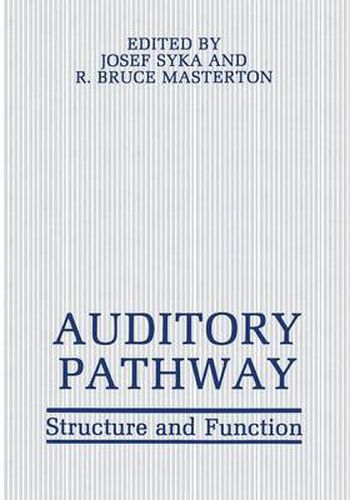Readings Newsletter
Become a Readings Member to make your shopping experience even easier.
Sign in or sign up for free!
You’re not far away from qualifying for FREE standard shipping within Australia
You’ve qualified for FREE standard shipping within Australia
The cart is loading…






This title is printed to order. This book may have been self-published. If so, we cannot guarantee the quality of the content. In the main most books will have gone through the editing process however some may not. We therefore suggest that you be aware of this before ordering this book. If in doubt check either the author or publisher’s details as we are unable to accept any returns unless they are faulty. Please contact us if you have any questions.
Since the last symposium on Neuronal Mechanisms of Hearing held in Prague in 1980 and published in the volume of the same name (J. Syka and L. Aitkin, Eds. , Plenum Press, 1981), remarkable progress has been achieved in the understanding of the auditory system. A variety of new ideas and new methods have emerged. This progress can be easily documented by comparing the volume based on the 1980 Symposium with the program for the 1987 Symposium. For example, there were 45 contributions to auditory physiology in each symposium but there were 27 contributions focusing on anatomy in 1987 as compared to 7 in 1980, and perhaps most telling, there were 12 contributions to the neurochemistry of the system in 1987 while there were only 3 in 1980. In terms of percentages of contributions, neuroanatomy rose from 13% to 32% and neurochemistry (or chemical anatomy) rose from 5% in 1980 to 14% in 1987. These increases in the numbers and proportions of anatomical and neurochemical contributions undoubtedly reflects the increasing availabil ity and rising expertise in the new neuroanatomica1 and biochemical techniques most notably, tract-tracing by exploitation of axonal transport or by intracellular micro-injection methods, and neurotransmitter identifi cation by use of immunocytochemistry or receptor-binding techniques. New ideas have emerged on the function of cochlear hair cells particularly in connection with olivococh1ear bundle stimulation and supported by findings of contractile proteins in outer hair cells.
$9.00 standard shipping within Australia
FREE standard shipping within Australia for orders over $100.00
Express & International shipping calculated at checkout
This title is printed to order. This book may have been self-published. If so, we cannot guarantee the quality of the content. In the main most books will have gone through the editing process however some may not. We therefore suggest that you be aware of this before ordering this book. If in doubt check either the author or publisher’s details as we are unable to accept any returns unless they are faulty. Please contact us if you have any questions.
Since the last symposium on Neuronal Mechanisms of Hearing held in Prague in 1980 and published in the volume of the same name (J. Syka and L. Aitkin, Eds. , Plenum Press, 1981), remarkable progress has been achieved in the understanding of the auditory system. A variety of new ideas and new methods have emerged. This progress can be easily documented by comparing the volume based on the 1980 Symposium with the program for the 1987 Symposium. For example, there were 45 contributions to auditory physiology in each symposium but there were 27 contributions focusing on anatomy in 1987 as compared to 7 in 1980, and perhaps most telling, there were 12 contributions to the neurochemistry of the system in 1987 while there were only 3 in 1980. In terms of percentages of contributions, neuroanatomy rose from 13% to 32% and neurochemistry (or chemical anatomy) rose from 5% in 1980 to 14% in 1987. These increases in the numbers and proportions of anatomical and neurochemical contributions undoubtedly reflects the increasing availabil ity and rising expertise in the new neuroanatomica1 and biochemical techniques most notably, tract-tracing by exploitation of axonal transport or by intracellular micro-injection methods, and neurotransmitter identifi cation by use of immunocytochemistry or receptor-binding techniques. New ideas have emerged on the function of cochlear hair cells particularly in connection with olivococh1ear bundle stimulation and supported by findings of contractile proteins in outer hair cells.